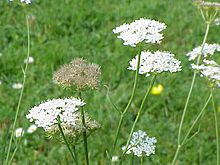Hucclecote Meadows facts for kids
| Site of Special Scientific Interest | |

Example - corky-fruited water dropwort (Oenanthe pimpinelloides)
|
|
| Area of Search | Gloucestershire |
|---|---|
| Coordinates | 51°50′44″N 2°11′11″W / 51.845601°N 2.186486°W |
| Interest | Biological |
| Area | 5.74 hectare |
| Notification | 1984 |
Hucclecote Meadows is a special natural area in Gloucestershire, England. It covers about 5.74 hectares, which is like nine football fields! This area is called a Site of Special Scientific Interest (SSSI) because it has important plants and animals. It was officially recognized as an SSSI in 1984.
The meadows are split into two parts by the M5 road. The part on the west side is also a Local Nature Reserve. This means it's a place where nature is protected, and people can visit to enjoy the outdoors and learn about wildlife.
Where are Hucclecote Meadows?
These meadows are located near the city of Gloucester. They are lowland meadows, which means they are flat and not very high up. The soil here is made of a type of clay called Lower Lias clay.
These meadows are very special because they are some of the last remaining "herb-rich" ancient pastures in Gloucestershire. "Herb-rich" means they have many different kinds of wildflowers and grasses, not just one or two. For a long time, people have used these meadows to grow hay and to let cattle and sheep graze. This traditional way of managing the land helps keep the meadows healthy and full of diverse plants.
Amazing Plants of the Meadows
Hucclecote Meadows are home to many different plant species. Each meadow might have slightly different plants growing in it. When the area was first studied, experts found about 75 different meadow plant species!
Some of these plants are quite rare. One example is the corky-fruited water dropwort. This plant is not found in many other places.
You can also find many common grasses here, like Yorkshire fog, meadow fescue, crested dog's-tail, and meadow foxtail.
Besides grasses, the meadows are full of beautiful wildflowers. Look for plants like great burnet, cowslip, devil's-bit scabious, saw-wort, lady's bedstraw, and yellow rattle.
The edges of the meadows are lined with very old hedges. These hedges are made up of plants like hawthorn and blackthorn. You might also see some larger trees like oak growing within these hedges.
Butterflies and Other Insects
The variety of plants in Hucclecote Meadows makes it a great home for many insects, especially butterflies! If you visit, you might spot several different kinds of butterflies fluttering around.
Some of the butterflies that have been seen here include the meadow brown, marbled white, common blue, grizzled skipper, and the small heath butterfly. These insects play an important role in the ecosystem, helping to pollinate the plants.

